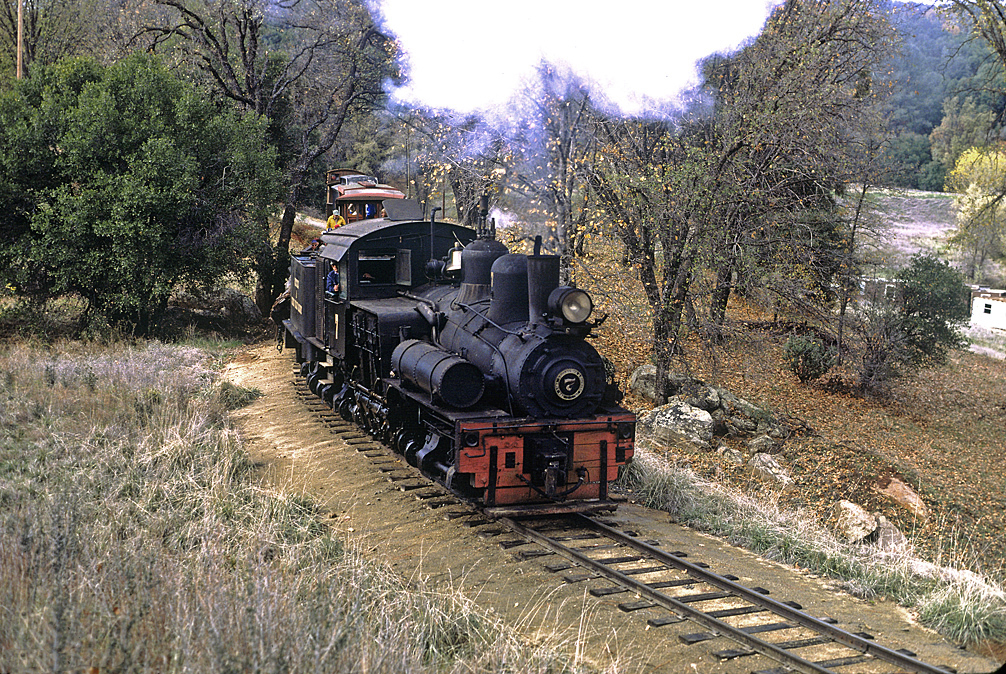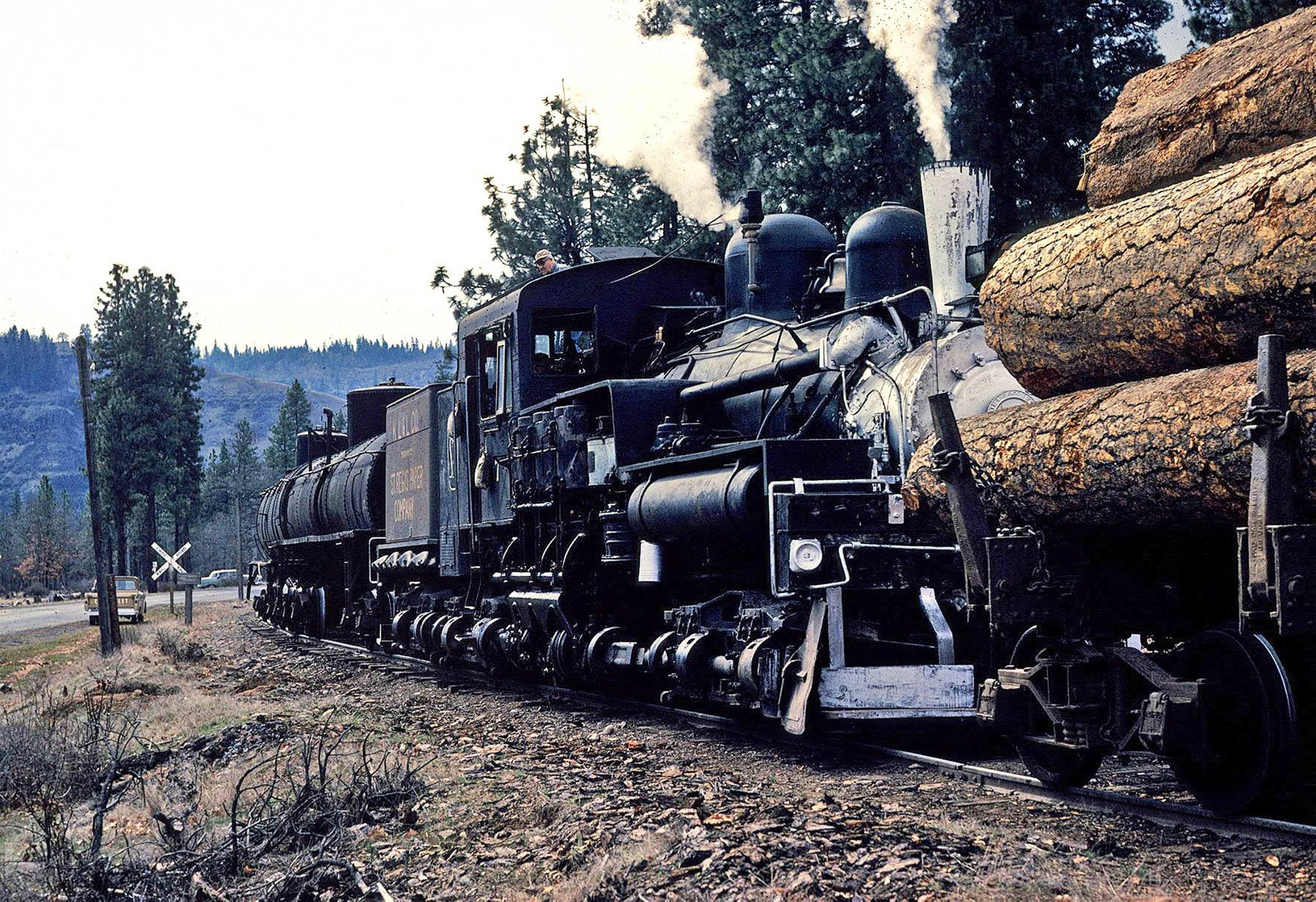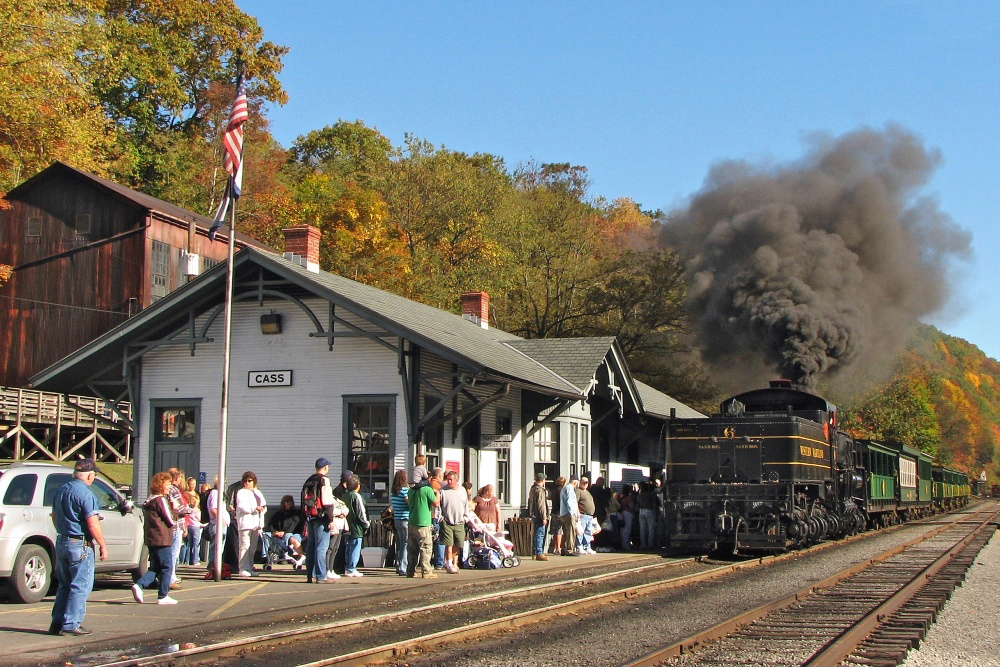Geared Steam Locomotives: Types, History, Development
Last revised: November 6, 2024
By: Adam Burns
The geared steam locomotive represents a fascinating chapter in the rich narrative of railway technology.
Unlike their more orthodox counterparts, geared designs were intended to negotiate the steep gradients and sharp curves encountered in rugged terrains, such as logging, mining, and mountainous areas.
Most were subsequently purchased by the private logging operations although even a few Class Is picked up geared designs to handle tough assignments on stiff branch lines, such as along the Great Northern and Western Maryland.
The critical advantage of geared locomotives lay in their engineering, which allowed them to generate high torque at low speeds—ideal for pulling heavy loads up torturous grades.
The gear mechanism drove the wheels more effectively, reducing the chances of wheel slip, a common problem in rod-driven steam locomotives. Moreover, their relatively light weight and ability to operate over poorly maintained and/or even track made them ideal for logging operations.
Geared locomotives epitomized the fusion of practical engineering with innovative design, making rail transport feasible in areas previously deemed inaccessible.
Today, several variants survive and a handful can still be found in operation, in particular the collection at the Cass Scenic Railroad in the mountains of West Virginia.
Photos
 Westside Lumber Company's big 3-truck Shay #7 pulls an excursion along the Westside & Cherry Valley Railroad near Tuolumne, California during November, 1981. Drew Jacksich photo.
Westside Lumber Company's big 3-truck Shay #7 pulls an excursion along the Westside & Cherry Valley Railroad near Tuolumne, California during November, 1981. Drew Jacksich photo.Inception
The inception of geared steam locomotives dates back to the late 19th century, a period marked by rapid industrial expansion that necessitated the exploitation of resources in increasingly remote locations.
Traditional rod-driven designs were not suited to the sharp curves and steep gradients typical of forested or mountainous terrains.
The solution lay in the development of a vertical or angled geared system for propulsion - as opposed to a standard horizontal driven rod - which allows for better traction at slower speeds, ideal for hauling heavy loads on uneven tracks.
According to William E. Warden in his book West Virginia Logging Railroads, in the case of the classic Shay its cylinders "...drive a flexible line shaft with universal couplings and slip joints through bevel gears."
This flexibility thus allows each truck to negotiate the track independently of the other, which keeps the locomotive on the rails, allowing it to operate over almost any type of track.
Types
Geared locomotives first appeared in the late 1870s when Ephraim Shay invented his now famous Shay locomotive, the most widely used of all geared designs.
Patented in June, 1881 by Ephraim Shay, his design featured a side-mounted set of cylinders that drove a longitudinal shaft. This shaft then powered gears connected to the trucks (wheel assemblies), which propelled the locomotive.
The design allowed all wheels to receive power simultaneously, providing exceptional traction. Shays were particularly dominant in the logging industry, where their ability to handle sharp curves and uneven tracks made them indispensable.
Shay's design was built exclusively by the Lima Locomotive Works in a variation of classes (Class A, B, C, and D) while the Willamette Iron & Steel Works manufactured a geared locomotive based from the Shay design. There were also other competing variants, most notably the Climax and Heisler.
Developed in the 1880s, the Climax offered a different approach. It utilized an inclined set of cylinders that drove a central crankshaft, which in turn powered the gears on each axle.
This design was simpler and more compact than the Shay and favored for its balance and more straightforward maintenance. Climax locomotives were versatile, used not only in logging but also in quarrying and general freight work.
 Klickitat Log & Lumber three-truck Shay #7 switches out loads of logs for the trip down to the mill at Klickitat, Washington during April of 1964. Drew Jacksich photo.
Klickitat Log & Lumber three-truck Shay #7 switches out loads of logs for the trip down to the mill at Klickitat, Washington during April of 1964. Drew Jacksich photo.According to William E. Warden in his book West Virginia Logging Railroads, the Climax gained adhesion by:
"...employing two cylinders, one on each side of the boiler. The cylinders were neither vertical nor horizontal at an angle of approximately 25 degrees and the piston rods were connected to a line shaft centered under the boiler and mid-way between the trucks which thus powered either two or three trucks. "
The last to enter the scene, the Heisler, was patented in 1892 by Charles L. Heisler. It featured a V-twin arrangement of cylinders that drove a central longitudinal driveshaft, which then powered the geared wheels through bevel gears. Heislers were known for their speed and stability compared to their counterparts and were commonly used in both logging and mainline services.
Success
Seeing these, and other types of geared locomotives in action was a true sight to behold. Not only could they operate over rough, uneven, and poor track conditions but also were designed in such a way that all wheels provided traction which afforded them tremendous levels of adhesion.
As a result, it was typical practice to see these machines haul logs up torturous grades well over 5%!
Shays did have an inherent flaw in that the poor track conditions could cause drive line length to change, which could cause the locomotives to run right off the rails for what appeared to be no reason at all.
In logging operations one could commonly see geared steamers fording streams and creeks as logging companies would lay down track right through these bodies of water! With no electric traction motors, as long as this cool water did not reach the boiler it posed no danger to the locomotive.
In addition, it saved logging operations thousands of dollars in engineering and bridge construction; once a tract of land had been logged, crews simply picked up the rails and moved on.
 Western Maryland 3-truck Shay "Big Six" arrives at the depot in Cass, West Virginia to take passengers on another trip to Bald Knob on October 12, 2008. Loyd Lowry photo.
Western Maryland 3-truck Shay "Big Six" arrives at the depot in Cass, West Virginia to take passengers on another trip to Bald Knob on October 12, 2008. Loyd Lowry photo.Legacy
The advent of internal combustion engines and the decline of industries like logging led to the gradual phasing out of geared steam locomotives by the mid-20th century.
However, their impact is enduring, as evidenced by the preservation of several of these magnificent machines in railway museums and heritage railways across the globe, where they continue to fascinate and educate history enthusiasts and railway aficionados alike.
In conclusion, the development of the geared steam locomotive not only solved practical mobility problems in challenging terrains but also showcased the ingenuity and adaptability of industrial-age engineering. These locomotives remain a testament to a bygone era, an indispensable part of the evolution of rail transportation.
Preservation
Today, all three of the major geared types not only
survive but also can still be found in operation on tourist railroads
across the nation, particularly the Shay. Perhaps the best place to
catch all three types in action is West Virginia.
Not only is the world famous Cass Scenic Railroad and its fleet of Shays and a Heisler located in Cass, West Virginia but also a short drive away you can catch the Durbin & Greenbrier Valley Railroad's Climax #3 hauling the Durbin Rocket on seasonal trips.
In February, 2023 the state of West Virginia, in conjunction with the Durbin & Greenbrier Valley/West Virginia Central/Cass Scenic Railroad, completed restoration of the old Chesapeake & Ohio's Greenbrier Division between Cass and Durbin along the Greenbrier River.
This segment of track had been washed out since the severe flooding of late 1985 and appeared unlikely to ever see a train again. Moving forward, one can ride this 15-mile segment behind either a Heisler, Shay, or one of the other locomotives owned by the West Virginia Central.
Sources
- Adams, Kramer A. Logging Railroads Of The West. New York: Bonanza Books, 1961.
- Fetters, Thomas. Logging Railroads Of South Carolina. Forest Park: Heimburger House Publishing Company, 1990.
- Fetters, Thomas. Logging Railroads Of The Blue Ridge And Smoky Mountains, Volume I (Gold Mountain, Black Mountain And White Top). Hillsboro: TimberTimes, 2007.
- Fetters, Thomas. Logging Railroads Of The Blue Ridge And Smoky Mountains, Volume 2 (Tallulah Falls, Anna Ruby Falls, And Jeffrey's Hell). Hillsboro: TimberTimes, 2010.
- Gove, Bill. Logging Railroads Of The Adirondacks. Syracuse: Syracuse University Press, 2006.
- Gove, Bill. Logging Railroads Of New Hampshire's North Country. Littleton: Bondcliffs Books, 2010.
- Kline Jr. Benjamin F.G. Tall Pines And Winding Rivers: The Logging Railroads Of Maryland. Strasburg: The Friends Of The Railroad Museum Of PA, 2007 (Second Edition).
- King, Frank A. Minnesota Logging Railroads. Minneapolis: University Of Minnesota Press, 2003 (First University Of Minnesota Press Edition).
- Labbe, John T. and Replinger, Peter J. Logging To The Salt Chuck. Seattle: North West Shore Line, 1990.
- Lawson Jr., Thomas. Logging Railroads Of Alabama. Birmingham: Cabbage Stack Publishing, 1996.
- Warden, William E. West Virginia Logging Railroads. Lynchburg: TLC Publishing, 1993.
Recent Articles
-
Ohio - Whiskey - Train Rides
Dec 24, 25 05:47 PM
Ohio, with its rich history and scenic landscapes, offers an unusual yet delightful experience for spirit enthusiasts and travel aficionados alike: whiskey train rides. -
California Thomas The Train Rides
Dec 24, 25 05:44 PM
Held at various railroad museums and heritage railways across California, these events provide a unique opportunity for children and their families to engage with their favorite blue engine in real-li… -
Texas Thomas The Train Rides
Dec 24, 25 05:42 PM
In the heart of Texas, where everything is said to be bigger and bolder, lies an event that captures the imagination of children and families alike - A Day Out With Thomas.



